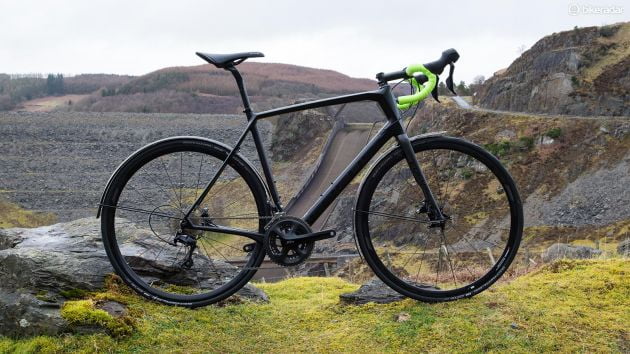
Focus has been quite clever with the Paralane’s design. Its endurance geometry (like Cervélo’s pricey C5) uses a longer fork and lower bottom bracket (BB), which means that far from the Paralane looking tall, or having a deep ungainly head tube, it retains a racy look and that’s despite having a very much endurance-biased 613mm stack and 395mm reach (on my XL/58cm test ride) — compared to the race-orientated Izalco Max that Focus’ pros ride, which is 30mm taller. I did switch a few spacers to above the stem to get a more aggressive position than was provided stock.
On the road, the Paralane feels every inch the modern disc road bike; the lightweight frame and fork are the basis for a stiff, direct feeling bike — and a feeling only enhanced by the RAT Evo thru-axles that anchor the made-for Focus Fulcrum wheels.
Out back, the Paralane feels solid, yet compliant. The clever design work at the back-end ‘pre-loads’ the slender seat stays and chainstays in a compressed form, so any bumps try and straighten the structure giving the rider an excellent level of compliance.
The seat tube is radically flattened just above the BB shell and again this is designed to flex more easily (like a leaf spring) so it works in unison with the clever stays. This is all topped by the brilliant CPX comfort post, which is specced in a Cannondale aping 25.4mm diameter.
Like Trek’s Domane, the Paralane’s back-end seems to work better the faster you go over poor road surfaces. It’s like you’re running fatter rubber than the brilliant 25c Schwalbe Ones and at a lower pressure too. Up front the super skinny and light fork is a good match for the 905g frame, it feels stiff and direct under steering, yet compliant when you hit lumps and bumps.
The Paralane was designed with the shortcut in mind (the design team often shot through a forest to find the best roads on their lunchtime rides), so it seemed only fair to get the Paralane off the beaten track. While it’s by no means a ‘gravel’ bike – the 25c Schwalbe One tyres certainly prove that rather than the more gravel-focused G-One — the balanced handling and clever chassis can handle rocks and roots without becoming sketchy, and the extra clearance afforded by the disc brakes and higher fork crown (for the adjusted geometry) mean you could easily get bigger rubber running should you want to try out getting dirty now and again.
Focus has to its credit really thought about the end user — riders that want long days in the saddle in comfort, on unpredictable surfaces and in unpredictable weather. So it’s good to see the Paralane ship with some very neat full length, full alloy guards. I got to try these out in some of 2016’s worst rainstorms and they stopped spray and remained rattle-free, which is all you could ever want from a set of guards. The slightly flattened shape also means plenty of room for bigger tyres and I think you could squeeze a set of 30s under them.

The wide 50/34, 11-32 gearing will appeal to riders who like to be challenged on the climbs, only wannabe racers will bemoan the larger jumps between sprockets, but most of us would prefer the bail out gear for when things get super steep when you’re super tired.
As for climbing, the Paralane’s chassis is stiff (and did I mention light), so it feels responsive and swift, but it’s slightly held back by the middleweight wheelset that the Fulcrum CEX 7.0DB is based on — Fulcrum’s Racing 5 DB, but with lower level 7 Series hubs. The Schwable One tyres impress and unlike the BMC Roadmachine the bike was designed around bigger, so let’s have ‘em!

The latest RAT Evo thru-axles used here are lighter than before and I guarantee are faster than a standard quick release with their incredibly quick quarter-turn and pull operation. Focus has made this an ‘open’ standard and I can’t believe more brands haven’t taken it up on the design — so far only Merida has chosen to go with RAT.
The commanding ride position makes for a confident handling bike through the turns, especially when descending. The RS505 brakes offer plenty of feel and power whatever the weather, but the standard (non-Ice Tech) rotors are a bit more prone to noise especially in the rain, but I can’t fault the stopping feel and performance.

Again, the bulky companion STi levers still divide opinion and again, apart from the aesthetics, I like the increased shape (especially when wearing winter gloves and riding the hoods). The wide, flat shape atop the clamp section is a little odd and some find this uncomfortable too, I didn’t, but would certainly recommend a try-before-you-buy approach here.
I’ve come round to expecting 105 at this price and there is certainly nothing-amiss performance wise, yes the added bling of Ultegra or similar is alluring, but save a few exceptions this is now the norm. It’s a beautifully finished, brilliant riding, do-it-all special that’s masterly on the road and no slouch over coarser stuff either.
Overall, I love the Paralane (even with its eighties’ heavy metal inspired graphics) because it occupies the middle ground between endurance bike and gravel, which makes it a great all-round option. Plus the geometry that sits between race and full-on endurance also makes sense to me and should to most of you too.
This article was originally published in Cycling Plus magazine, available on Apple Newsstand and Zinio.
[“Source-bikeradar”]
